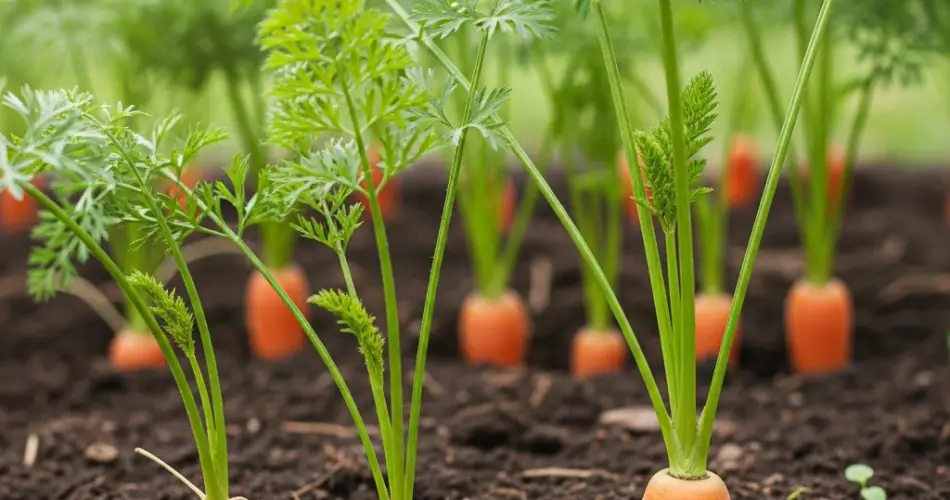Think you need a big garden to grow carrots? Think again. Carrots are one of the easiest root vegetables to grow—even in small spaces. With the right container, soil, and a few practical techniques, you can grow sweet, crunchy carrots on a balcony, patio, or even a sunny window ledge.
This guide shows you how to grow carrots in limited space without sacrificing quality or yield. Whether you’re a beginner or a seasoned gardener, these simple tricks will help you enjoy a steady supply of homegrown carrots with minimal effort.
Why Carrots Are Great for Small Spaces
Carrots don’t need much horizontal room, but they do require loose, deep soil to grow straight and healthy roots. That makes them perfect candidates for container gardening or raised beds. When grown in the right conditions, even a small planter can produce a surprisingly large harvest.
Growing carrots in small spaces has several advantages:
-
You can control the soil quality and drainage.
-
They’re less prone to pests like carrot flies.
-
You can move containers to optimize sunlight exposure.
-
It’s easier to manage watering and maintenance in a compact setup.
Choosing the Right Carrot Variety
Not all carrots are the same, and some varieties are better suited for small or shallow containers.
-
Parisian Round: These small, round carrots grow well in shallow containers.
-
Thumbelina: Another compact variety ideal for pots.
-
Short ‘n Sweet: Bred for container growing and shallow soils.
-
Little Finger: Thin, baby-style carrots perfect for small planters.
If you have a deeper pot (at least 12 inches), you can try standard varieties like Nantes or Danvers as well.
What You’ll Need
-
A container at least 8–12 inches deep (larger is better)
-
Lightweight, well-draining potting mix
-
Carrot seeds (not seedlings)
-
A sunny location (at least 6 hours of direct sun per day)
-
Watering can or hose with a gentle spray nozzle
Preparing Your Growing Space
-
Choose the Right Container: Buckets, grow bags, deep window boxes, or large plant pots all work well. Ensure there are adequate drainage holes at the bottom.
-
Fill with Proper Soil: Carrots prefer loose, sandy, well-drained soil. Use a mix of potting soil, sand, and compost. Avoid clay-heavy soil, which can hinder root growth.
-
Smooth the Surface: Level the soil and gently firm it down without compacting it too tightly. Carrot seeds are tiny and need good contact with the soil.
Sowing the Seeds
-
Sow seeds directly into the container, spacing them about 1 inch apart.
-
Cover lightly with a thin layer of soil—no more than ¼ inch.
-
Water gently using a fine spray to avoid displacing the seeds.
-
Keep the soil consistently moist until the seeds germinate (usually within 7–14 days).
Pro Tip: You can mix carrot seeds with a bit of dry sand to help distribute them more evenly when sowing.
Thinning for Better Growth
Once the seedlings are about 2 inches tall, thin them out to give each plant room to grow. Leave about 2 inches between each seedling. This allows the roots to develop without competition, resulting in larger, straighter carrots.
Don’t skip this step—crowded carrots will grow small, twisted, or forked.
Watering and Sunlight
-
Watering: Carrots need consistent moisture. Dry soil can lead to split roots, while overly wet soil may cause rot. Water deeply when the top inch of soil feels dry.
-
Sunlight: Carrots need full sun for best growth. Place containers in a sunny spot that gets at least 6 hours of light daily.
Feeding
Carrots generally don’t need heavy fertilizing. If your soil mix is rich in compost, that may be enough. However, if growth seems slow, you can apply a diluted liquid fertilizer once or twice during the growing season. Avoid high-nitrogen fertilizers—they promote leafy tops at the expense of the root.
Protecting Your Carrots
-
Mulch: Adding a thin layer of mulch helps retain moisture and keeps the soil temperature stable.
-
Pests: Container-grown carrots face fewer pest problems, but you can still cover them with garden fleece or mesh to prevent issues with aphids or carrot flies.
Harvesting
Carrots are usually ready to harvest 60–75 days after planting, depending on the variety. Look for mature tops peeking out of the soil. Gently pull or loosen the soil before harvesting to avoid breaking the roots.
You can also harvest earlier for baby carrots, which are tender and sweet.
Tips for Success
-
Keep the soil moist but not soggy throughout the growing period.
-
Avoid disturbing the soil once the carrots are growing—this can affect root shape.
-
Use fresh seeds each season for the best germination rates.
Final Thoughts
You don’t need a big garden to enjoy a healthy carrot harvest. With the right variety, proper soil, and a sunny spot, you can grow crisp, delicious carrots in buckets, boxes, or bags. This simple and satisfying project is perfect for beginner gardeners, apartment dwellers, or anyone who wants to make the most of a small space. Give it a try—your salads and stews will thank you!



